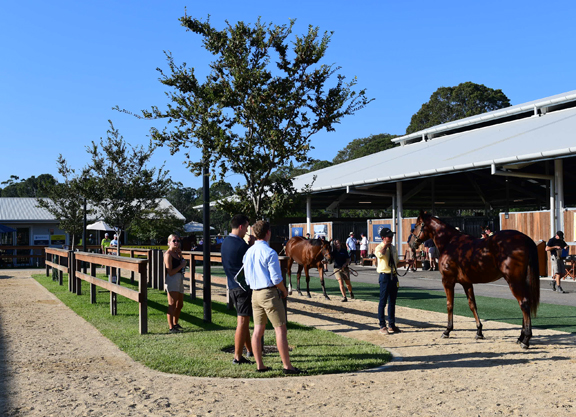By Bill Finley
When Tom Ryan of SF Bloodstock made his most recent trip to the 2019 Australian Easter Yearling Sale, he noticed firsthand how the process of scoping yearlings at an Australian sale is handled. The horse is scoped just once using state-of-the-art video scopes and the images are either put in the repository or kept by the consignors to show anyone who wants to examine the yearling.
Being heavily involved in the industry in Australia and abroad, Ryan had already known that such systems were in place at the major sales in several different countries, but seeing in person how well it worked–how simple it was and that it seemed to serve the best interests of all parties–he couldn't believe that such a system had not been adopted at U.S. sales.
Here, there's no limit to how many times a horse can scoped. Yearlings drawing a lot of attention from buyers might be scoped as many as 25 times by 25 different vets. To Ryan, after seeing how things were done in Australia, this made no sense.
“Watching horses all these years at U.S. yearling sales being twitched and scoped, five, 10, 15, 20 times, depending on their level of popularity, it is just so unnecessary,” Ryan said. “I was in Australia and watched the sales process, where the veterinarian breezes in and breezes out of the stall and a few minutes later with the click of a mouse you can see perfect images of what the scope shows. The horse goes right back to the stall resting in a very safe environment. It's safer for the handlers, safer for the veterinarians.”
Though there has been some resistance from veterinarians to changing the system, most involved with the sales industry have come to agree that the way scoping is done in Australia is simply a better system. Dr. Michael Hore, a veterinarian with Hagyard Equine Medical Institute, also expressed his support to changing the system.
“I am very much in support of bringing in the technology to implement video scopes into the repository system or have them at the barn for a veterinarian to be able to look at, and for several reasons,” Hore said. “One is to improve logistics. Many times it can be quite chaotic if you're trying to perform an endoscopic exam so potential buyers can look at a horse. I think it will help everybody involved, the seller, the buyer, the veterinarians, the horse itself. Every year the technology is getting better. Our scopes are so small the horse can't even feel it going in.
This change is going to happen and it will be the best for everybody.”
Hore explained that there are numerous reasons why a horse needs to be scoped before going into the sales ring, as the information the images provides is a valuable asset to potential buyers.
“We're scoping the upper airway,” he said. “We're looking for conditions of sale. The are seven conditions of sale that make a horse not suitable for sale. We are looking for those things, whether it be a paralyzed throat, a displaced soft palate, any kind of infection. We are looking for things that we think could lead to potential problems down the road when the horse is ready to become a race horse.”
You cannot blame a veterinarian or a potential owner for wanting this information and there are still some vets who prefer to do the procedure themselves. But one consignor, Reiley McDonald, argues that the current way of doing things causes so many problems and reaps so few benefits that he can't see how anyone can argue against making this change.
“It's inhumane to go in there and scope a horse as many as 25 times, and I've heard of horses that have been scoped that many times,” he said. “It's inhumane, it's dangerous for the horse and for the people holding the horse and the veterinarians. We've all seen a yearling backed into a corner, his eyes wide open and having a scope put in them and some whacking their heads on the ceiling, The scoping results we gets at the sales also change from the first day we get there to the second day to the third day to the day they sell. It can change depending on how tired the horse is, how hot it is outside, how many times the horse is being shown and how the horse is handling the stress of sale. They all handle it differently. My view is that all buyers aren't getting the same information on the same horse because it is a dynamic result. It would much better if everyone were looking at the same information.”
Apparently, the two biggest sales companies in the U.S. won't be making any changes overnight, but both Keeneland and Fasig-Tipton admit interest in adopting the new system.
“We agree, and have been meeting with the Consignors and Commercial Breeders Association and members of the veterinary community to determine how to assemble a working protocol that affords buyers the confidence they need in reviewing airways, while accommodating the unique burdens of the domestic marketplace that can have 4,000 plus horses on offer over a short period of time, said Bob Elliston, Keeneland Vice President of Racing and Sales. “The technology and capabilities of veterinarians to utilize these tools is improving rapidly, and we would like to be in position to extend our repository benefits to video scoping as soon as practical.”
Fasig-Tipton also seems prepared to make the change.
“We're always looking for ways to improve the existing sales system in a sound environment and there certainly have been and will continue to be discussions about evaluating the feasability of implementing a similar (scoping) system here in the U.S. at our sales,” said Fasig Tipton President Boyd Browning. “Nothing has been finalized at this point, but it is on our radar screen.”
Browning said there is very little chance any changes would be made before the 2019 yearling sales. But 2020 may be the year a horse will be scoped once and then the images will be available to everyone.
“It's very simple,” Ryan said. “This is called progress and as for anybody standing in the way of this I'd like to hear their explanation.”
Have feedback about this article? Please email TDN V.P. of International Operations Gary King at [email protected].
Not a subscriber? Click here to sign up for the daily PDF or alerts.






